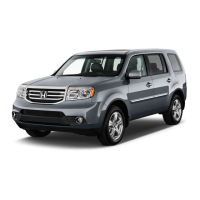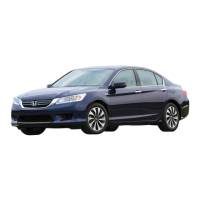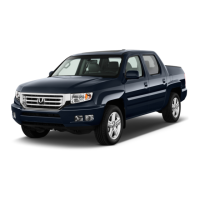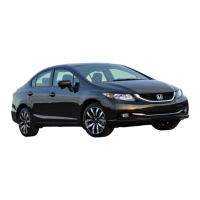Do you have a question about the Honda 2014 Pilot and is the answer not in the manual?
Always wear your seat belt, restrain all children, be aware of airbag hazards, and don't drink and drive.
Seat belts are the most effective safety device, keeping you connected to the vehicle and protected in crashes.
Airbags inflate with tremendous force to protect occupants in moderate-to-severe collisions, but can cause injury if not used properly.
Protect children by properly restraining them in rear seats according to age, height, and weight.
Vehicle emits toxic carbon monoxide gas; do not run the engine in confined spaces to avoid accumulation.
Explains the meaning and function of various dashboard indicators and warning lights.
Details the speedometer, tachometer, fuel gauge, and other related indicators.
Lists messages that appear on the multi-information display for warnings and helpful information.
Provides instructions on how to adjust the vehicle's clock time and format.
Explains how to lock/unlock doors using the key, remote transmitter, or inside controls.
Details the operation of the tailgate and glass hatch, including precautions.
Describes the function of various controls like ignition, turn signals, lights, wipers, and cruise control.
Covers manual and power seat adjustments, including seat-back, head restraints, and position memory.
Explains automatic and manual climate control operation, including defrost and rear climate controls.
Introduces the audio system, its capabilities, and operation via panel controls or steering wheel.
Details how to use the audio system, including screen navigation, playback modes, and audio settings.
Explains how to program the HomeLink system to operate garage doors and other devices.
Covers pairing phones, making/receiving calls, and managing contacts via the HFL system.
Provides instructions for compass calibration and zone selection to ensure accurate direction readings.
Details essential checks and preparations before starting the vehicle, covering exterior and interior aspects.
Covers towing preparation, load limits, equipment, trailer brakes, lights, and safe towing practices.
Provides guidance on starting the engine, precautions during driving, and system operations like cruise control and VSA.
Explains how to use cruise control for maintaining speed, adjusting it, and canceling the system.
Monitors tire pressure, explains indicator lights, and provides guidance on checking tire pressure.
Details the parking brake, foot brake system, ABS, and brake assist system operation.
Covers procedures for parking the vehicle, using parking sensors, and rearview camera operation.
Provides fuel recommendations, tank capacity, and step-by-step instructions on how to refuel the vehicle.
Outlines inspections, safety precautions, and types of maintenance required for the vehicle.
Details checks and maintenance items located under the hood, including fluids and filters.
Provides instructions on inspecting and changing front and rear wiper blade rubber.
Covers checking tire inflation, inspection guidelines, tire labeling, and wear indicators.
Explains how to check and charge the vehicle's battery, including safety precautions.
Details how to replace the button battery in the remote transmitter.
Explains the maintenance of the climate control system's dust and pollen filter.
Provides guidance on interior and exterior care, including cleaning seat belts, floor mats, and the vehicle body.
Lists and illustrates the tools provided with the vehicle for changing a flat tire or towing.
Provides step-by-step instructions for changing a flat tire, including preparation and storage.
Offers troubleshooting steps for when the engine does not start, checking the starter, fuses, and fuel level.
Explains how to handle engine overheating, including immediate actions and checking the cooling system.
Details various indicator lights on the instrument panel, their meanings, and recommended actions.
Provides fuse locations in different fuse boxes and guidance on inspecting and changing fuses.
Advises on calling professional towing services and describes acceptable towing methods.
Lists vehicle specifications, engine details, fluid types, battery, washer fluid, and light bulb information.
Shows the locations of the Vehicle Identification Number (VIN), engine number, and transmission number.
Lists vehicle systems that emit radio waves and their compliance with FCC and Industry Canada standards.
Provides contact information and procedures for reporting vehicle safety defects in the U.S. and Canada.
Explains readiness codes for emissions testing and the procedure to ensure they are properly set.
Outlines the new vehicle limited warranty, emissions warranty, seat belt warranty, and rust perforation warranty.
Information on how to purchase service, electrical troubleshooting, and body repair manuals.
Provides contact details for Honda Customer Services in the U.S., Canada, and Puerto Rico.
Legal agreement for the Gracenote music recognition software and data used in the vehicle.
Always wear your seat belt, restrain all children, be aware of airbag hazards, and don't drink and drive.
Seat belts are the most effective safety device, keeping you connected to the vehicle and protected in crashes.
Airbags inflate with tremendous force to protect occupants in moderate-to-severe collisions, but can cause injury if not used properly.
Protect children by properly restraining them in rear seats according to age, height, and weight.
Vehicle emits toxic carbon monoxide gas; do not run the engine in confined spaces to avoid accumulation.
Explains the meaning and function of various dashboard indicators and warning lights.
Details the speedometer, tachometer, fuel gauge, and other related indicators.
Lists messages that appear on the multi-information display for warnings and helpful information.
Provides instructions on how to adjust the vehicle's clock time and format.
Explains how to lock/unlock doors using the key, remote transmitter, or inside controls.
Details the operation of the tailgate and glass hatch, including precautions.
Describes the function of various controls like ignition, turn signals, lights, wipers, and cruise control.
Covers manual and power seat adjustments, including seat-back, head restraints, and position memory.
Explains automatic and manual climate control operation, including defrost and rear climate controls.
Introduces the audio system, its capabilities, and operation via panel controls or steering wheel.
Details how to use the audio system, including screen navigation, playback modes, and audio settings.
Explains how to program the HomeLink system to operate garage doors and other devices.
Covers pairing phones, making/receiving calls, and managing contacts via the HFL system.
Provides instructions for compass calibration and zone selection to ensure accurate direction readings.
Details essential checks and preparations before starting the vehicle, covering exterior and interior aspects.
Covers towing preparation, load limits, equipment, trailer brakes, lights, and safe towing practices.
Provides guidance on starting the engine, precautions during driving, and system operations like cruise control and VSA.
Explains how to use cruise control for maintaining speed, adjusting it, and canceling the system.
Monitors tire pressure, explains indicator lights, and provides guidance on checking tire pressure.
Details the parking brake, foot brake system, ABS, and brake assist system operation.
Covers procedures for parking the vehicle, using parking sensors, and rearview camera operation.
Provides fuel recommendations, tank capacity, and step-by-step instructions on how to refuel the vehicle.
Outlines inspections, safety precautions, and types of maintenance required for the vehicle.
Details checks and maintenance items located under the hood, including fluids and filters.
Provides instructions on inspecting and changing front and rear wiper blade rubber.
Covers checking tire inflation, inspection guidelines, tire labeling, and wear indicators.
Explains how to check and charge the vehicle's battery, including safety precautions.
Details how to replace the button battery in the remote transmitter.
Explains the maintenance of the climate control system's dust and pollen filter.
Provides guidance on interior and exterior care, including cleaning seat belts, floor mats, and the vehicle body.
Lists and illustrates the tools provided with the vehicle for changing a flat tire or towing.
Provides step-by-step instructions for changing a flat tire, including preparation and storage.
Offers troubleshooting steps for when the engine does not start, checking the starter, fuses, and fuel level.
Explains how to handle engine overheating, including immediate actions and checking the cooling system.
Details various indicator lights on the instrument panel, their meanings, and recommended actions.
Provides fuse locations in different fuse boxes and guidance on inspecting and changing fuses.
Advises on calling professional towing services and describes acceptable towing methods.
Lists vehicle specifications, engine details, fluid types, battery, washer fluid, and light bulb information.
Shows the locations of the Vehicle Identification Number (VIN), engine number, and transmission number.
Lists vehicle systems that emit radio waves and their compliance with FCC and Industry Canada standards.
Provides contact information and procedures for reporting vehicle safety defects in the U.S. and Canada.
Explains readiness codes for emissions testing and the procedure to ensure they are properly set.
Outlines the new vehicle limited warranty, emissions warranty, seat belt warranty, and rust perforation warranty.
Information on how to purchase service, electrical troubleshooting, and body repair manuals.
Provides contact details for Honda Customer Services in the U.S., Canada, and Puerto Rico.
Legal agreement for the Gracenote music recognition software and data used in the vehicle.
| Brand | Honda |
|---|---|
| Model | 2014 Pilot |
| Category | Automobile |
| Language | English |












